The Retail Radeon HD 7870 Review: HIS 7870 IceQ Turbo & PowerColor PCS+ HD7870
by Ryan Smith on March 19, 2012 9:00 AM EST- Posted in
- GPUs
- AMD
- PowerColor
- Radeon HD 7000
- HIS
Power, Temperature, & Noise
Up next, we wrap up our look at a new video card’s stock performance with a look at the physical performance attributes: power consumption, temperatures, and noise. Thanks to TSMC’s 28nm process the 7800 series is already setting a new bar for the amount of performance they offer under 200W. How can these factory overclocks and custom coolers capitalize on that? Let’s find out.
| Radeon HD 7870 Voltages | ||||
| Ref 7870 Load | HIS IceQ Turbo 7870 Load | PowerColor PCS+ HD7870 Load | ||
| 1.219v | 1.219v | 1.219v | ||
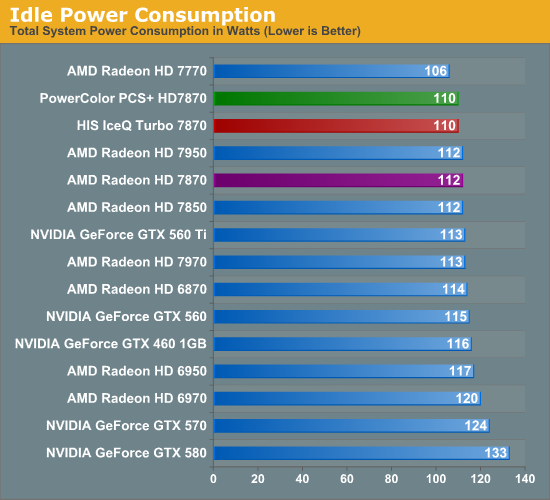
Since both the PCS+ HD7870 and IceQ Turbo 7870 are semi-custom designs using AMD’s PCB, the impact they can have on idle power usage is minimal, but not non-existent. Our tests register a 2W difference, which may be due to the different fans these designs use, or perhaps a consequence of the slightly lower idle temperatures they hit.

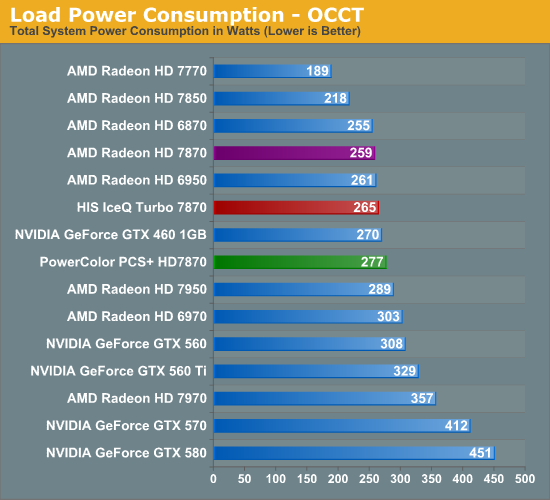
Load power consumption ended up being more wild than we expected. At 331W under Metro and 277W under OCCT, the PCS+ HD7870 performs how we’d expect an overclocked 7870 to perform. That is to say that power usage has increased slightly, but since there’s no increase in core voltage the difference is 20W or less at the wall, confirming the fact that these factory overclocks have little impact on power consumption and are largely free.
But then we have the IceQ Turbo 7870, which barely registers above the reference 7870. Why the difference? It comes down to two things; one of course is chip-to-chip variability, but there’s also the matter of the relationship between leakage and temperatures. As we’ll see when we get to our temperature testing, the IceQ Turbo is so effective at cooling that it stays nearly 10C under the other 7870s, which reduces the power consumption of the GPU.
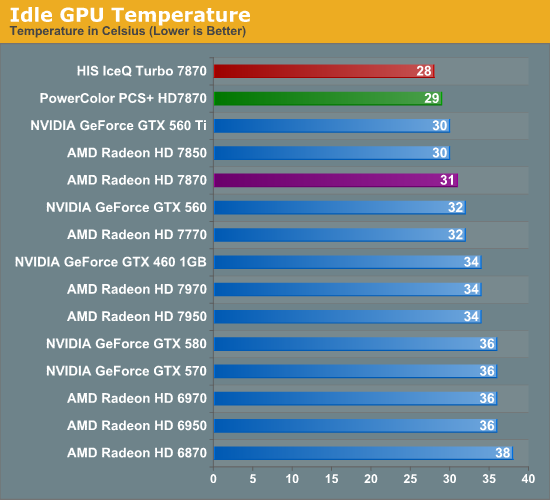
There are no big surprises under idle temperatures, but open air coolers once again lead the pack. With both cards having idle temperatures below 30C, neither card is getting a whole lot warmer than the room temperature.
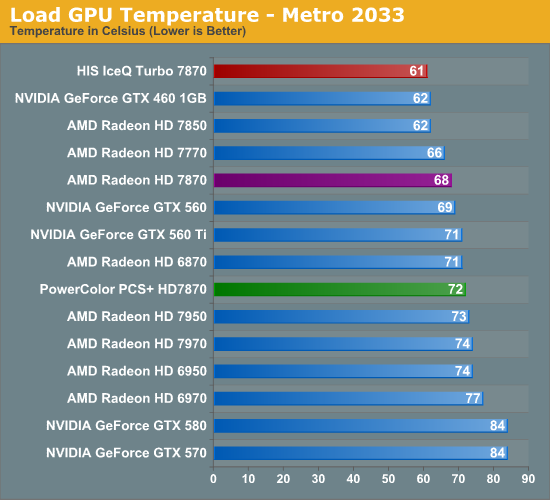
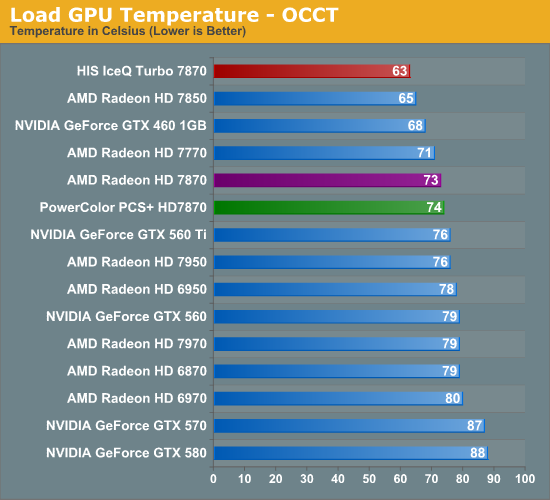
It’s once we get to load temperatures that we really get an interesting situation on our hands. The PCS+ HD7870 ends up being up to a few degrees warmer than the reference 7870, thanks to the recirculation of hot air due to the open air cooler, and the use of a stacked DVI design that further limits external venting. As we’ll see this is a temperature/noise tradeoff, and not a bad one to make given AMD’s aggressive cooling on the 7000 series, but the result is that the PCS+ 7870 is warmer.
Then we have the IceQ Turbo 7870. The IceQ is effectively a triple wide card and it has the cooling performance to go with it. At 61C under Metro and 63C under OCCT it’s cooler than any modern reference card, even the GTX 460. 63C under OCCT for a 190W card is especially impressive and not very easy to accomplish. The IceQ is one cool card, literally. But does it have the noise to match its cool demeanor?
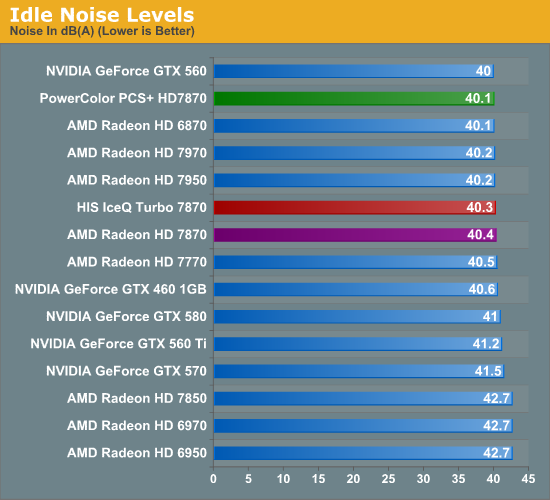
Idle noise levels are consistent. Both cards are ever so marginally quieter than the reference 7870 at idle.
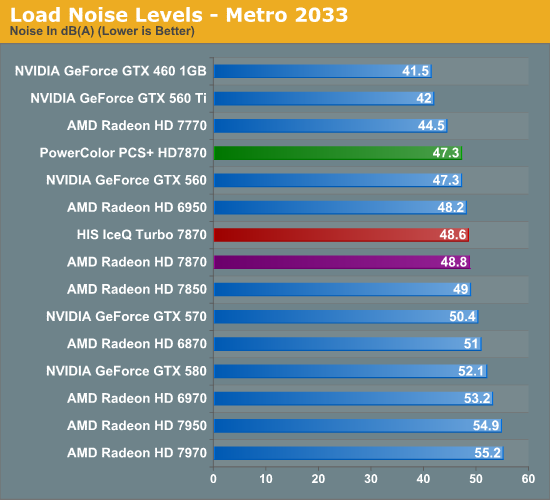
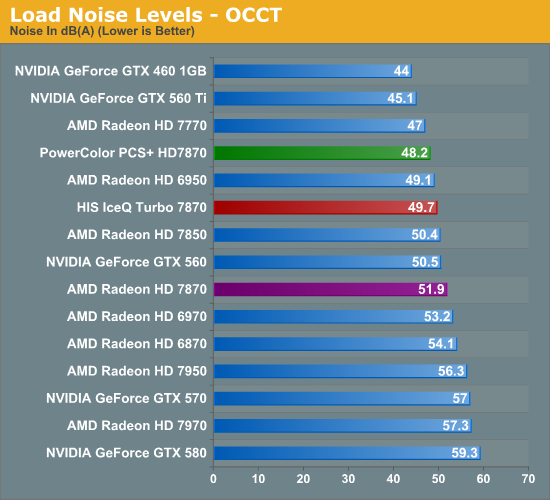
When it comes to load noise, both cards show their superiority over the reference 7870. The PCS+ HD7870 makes the temperature/noise tradeoff we mentioned earlier, and as a result it’s anywhere between 1.5dB and 3.7dB quieter than the reference 7870, keeping the card at a cozy noise level below 50dB. This isn’t the domain of silent cards, but you can do very well for fairly little noise.
The IceQ Turbo 7870 ends up being a surprise. Numerous times before we’ve seen loud & cool cards, but it’s rare to come across a quiet and cool card. In spite of the large blower on the card and the temperatures we’ve seen, the IceQ Turbo does well for itself, ending up quieter than the reference 7870 in both tests. It can’t reach the PCS+ HD7870 here, but it still manages to stay below 50dB, which makes it’s sub-65C temperatures we saw earlier all the more impressive.
All things considered both cards do well for themselves in our power/temp/noise testing, which is what we’d expect for open air coolers (and hybrids) going up against AMD’s reference 7870 and its complete blower design. There is an obvious tradeoff that should not be ignored here – both cards are circulating much more hot air inside of the case, making an airy case a wise partner for these cards, but if you have the right case you can beat the blower. Otherwise in a stuffy case both cards would be ill advised given just how much of that 190W can find its way back inside the case.










53 Comments
View All Comments
CeriseCogburn - Wednesday, March 21, 2012 - link
But for a long period of time you kept the very same drivers in many released articles, listed right along, one run for AMD drivers was over a year long as I recall or it certainly seemed, as well as for nVidia, and those were recent. you were asked about it and claimed the 10.3a drivers or whatever it was, were nearly identical to never ones so you weren't going to redo all the tests.So your excuse holds no water, you never updated all the time even in regular release benches.
If we accept your answer, it invalidates probably 90%+ of all your reviews.
CeriseCogburn - Wednesday, March 21, 2012 - link
It's reasonable if here they take the short time to assemble the "overclocked chart" they obviously have the data for with all the prior released cards they include in the article, and show one fair game with the respective included cards all OC'ed.Without that there is no real justification, nor is it fair or equitable, or honest.
Peanutsrevenge - Tuesday, March 20, 2012 - link
Thanks for the reply Ryan.From all the replies to replies, I think it's clear.
You'll never be able to please everyone all the time :D
Still, nice review and always come to Anandtech when I'm looking for trustworthy information.
Keep up the good work and good luck with us whiners ;)
CeriseCogburn - Wednesday, March 21, 2012 - link
I think that's just a cop-out. One chart of a neutral game with all the cards OC'ed would be good enough to appease everyone. It would solve the problem.CeriseCogburn - Wednesday, March 21, 2012 - link
Yes, as in the case of the highly overclockable GTX460 EVGA the complaints never ended when it was included without other cards being overclocked.It appears they excused themselves then, and decided promoting amd OC cards in a (near paper and completely unmentioned in the entire article) launch now was iresistable.
I noted the excuse, that AIB's would be bypassing stock cards...(for the most part) - which isn't correct either - as the truth is permission for OC cards at launch is the near difference from the usual standard.
All of them will still issue stock and OC for more money 'for the most part'.
I seriously doubt you can find a single launch in the entire archive that OC's the two launching ( or even one) nVidia card and nothing else.
That of course proves nothing since this is a very special case, one that AMD has approved.
johnpombrio - Monday, March 19, 2012 - link
This will probably be the last AMD release before NVidia comes out with their GTX 680 on March 22. AMD has been making up for the different release times by putting as much product out there as possible while NVidia tries to fix their manufacturing yields. It will interesting to see what happens in the next 6 months.Let the games begin.
CeriseCogburn - Wednesday, March 21, 2012 - link
Which isn't much product at all especially the 7870's and 7850's.MrSpadge - Tuesday, March 20, 2012 - link
I keep hearing how great the SI GPUs overclock on stock voltage. However, that voltage is set to 1.2 V. From my point of view that's already a lot - my HD6950 on a 40 nm process runs at just 1.10 V. It reminds me of AMDs 45 nm CPUs which are set to painful 1.40 V and reviewers are pleased with their overclockability.. not withstanding the fact htat it should have been 1.30 V for better stock efficiency.In the same spirit I think the SI GPUs should get lower stock voltages.. higher efficiency and still plenty of head room.
Onus - Tuesday, March 20, 2012 - link
That was a constructive discussion on the overclocking comparison. I think it is meaningful if only because it adds another data point to the "index" we all maintain when working on configurations or contemplating upgrades. Overclocking may be extremely variable, but if all of a handful of tech sites get only a 5% OC, that tells something.The power usage figures of the new AMD cards look great, especially considering the performance. Now I just hope prices can come down some.
CeriseCogburn - Wednesday, March 21, 2012 - link
They have the data to include a neutral type game with all the cards overclocked, and it would be helpful and easily repeatable, and the excuse that every new driver would need to be used is refuted by the entensive archive here where old drivers were used for extensive periods of time.It appears bias or laziness and excuses is the real answer.